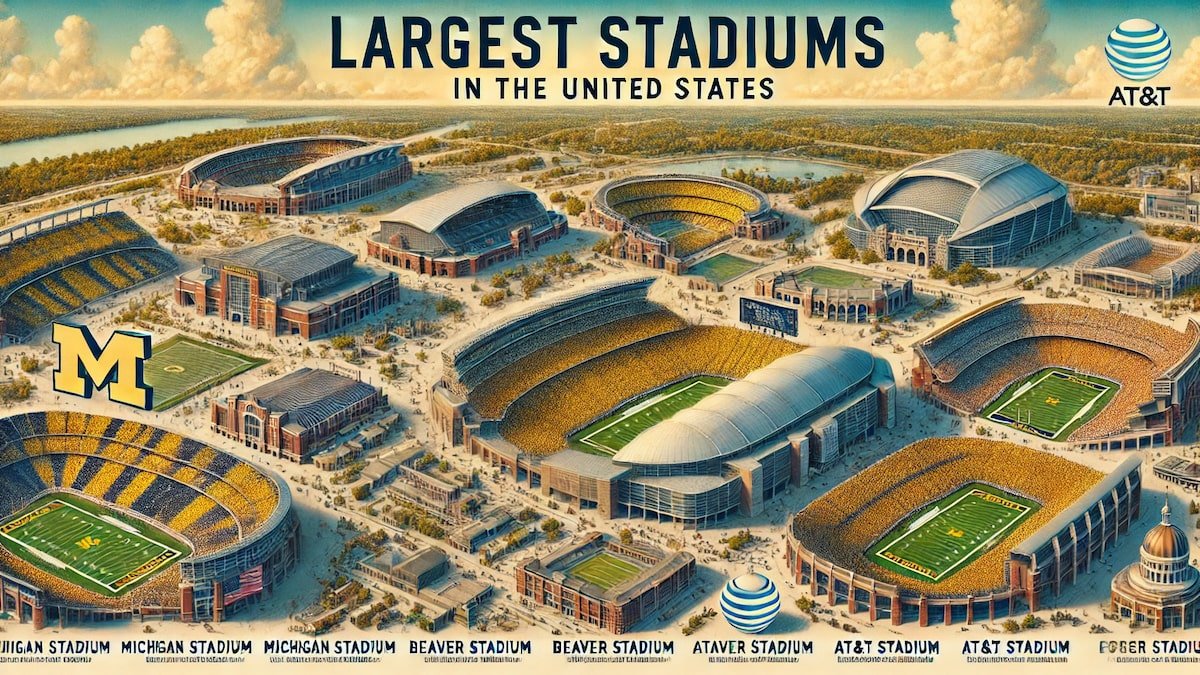Table of Contents
ToggleMichigan Stadium is the largest in the Largest Stadiums in the United States ranking, with a capacity of 107,601, followed by Beaver Stadium, Ohio Stadium, Kyle Field, and Tiger Stadium. In this article, we’ll explore the top 10 Largest Stadiums in the United States in 2024, highlighting their history, year of opening, location, capacity, and cultural significance.

Largest Stadiums in the United States
- Michigan Stadium – Capacity: 107,601
- Beaver Stadium – Capacity: 106,572
- Ohio Stadium – Capacity: 102,780
- Kyle Field – Capacity: 102,733
- Tiger Stadium – Capacity: 102,321
- Neyland Stadium – Capacity: 101,915
- Darrell K Royal-Texas Memorial Stadium – Capacity: 100,119
- Bryant-Denny Stadium – Capacity: 100,077
- Sanford Stadium – Capacity: 92,746
- Rose Bowl – Capacity: 92,542
1. Michigan Stadium
Michigan Stadium, located in Ann Arbor, Michigan, is the largest stadium in the United States, with a seating capacity of 107,601. It first opened in 1927 and has since become one of the most iconic venues in college football. Primarily used for football, the stadium serves as the home for the Michigan Wolverines (NCAA), drawing huge crowds for each game. Known as “The Big House,” it has a rich history and continues to be a central part of the University of Michigan’s athletic culture.
Interesting Fact: Michigan Stadium has a unique feature—it has hosted crowds much larger than its official capacity. The attendance record is over 115,000 spectators, set during a Michigan vs. Notre Dame game in 2013. Additionally, it occasionally hosts non-sporting events, including outdoor hockey games and concerts, making it a versatile venue.
| Stadium Name | Michigan Stadium |
|---|---|
| Capacity | 107,601 |
| City | Ann Arbor |
| State | Michigan |
| Year Opened | 1927 |
| Type | Football |
In the ranking of the Largest Stadiums in the United States, Michigan Stadium is the largest stadium with a capacity of 107,601.
2. Beaver Stadium
Interesting Fact: Beaver Stadium holds the record for the highest attendance at a college football game, with 110,753 spectators during a matchup against Michigan in 2013. The stadium is renowned for its “White Out” games, where fans wear white to create a visually stunning environment, adding to the excitement of home games.
| Stadium Name | Beaver Stadium |
|---|---|
| Capacity | 106,572 |
| City | University Park |
| State | Pennsylvania |
| Year Opened | 1960 |
| Type | Football |
In the ranking of the Largest Stadiums in the United States, Beaver Stadium is the second-largest stadium with a capacity of 106,572.
3. Ohio Stadium
Ohio Stadium, located in Columbus, Ohio, is the third-largest stadium in the United States, with a seating capacity of 102,780. Opened in 1922, this historic venue is primarily used for college football and serves as the home for the Ohio State Buckeyes (NCAA). Known as “The Horseshoe” due to its distinctive shape, Ohio Stadium has a rich tradition and is celebrated for its passionate fanbase, creating an electric atmosphere during game days. It has become a significant landmark for both the university and the city of Columbus.
Interesting Fact: Ohio Stadium has hosted numerous significant events, including the Ohio State-Michigan rivalry, one of the most storied rivalries in college sports. The stadium is also famous for its pre-game traditions, including the Script Ohio performance by the Ohio State University Marching Band, which is a highlight of every home game.
| Stadium Name | Ohio Stadium |
|---|---|
| Capacity | 102,780 |
| City | Columbus |
| State | Ohio |
| Year Opened | 1922 |
| Type | Football |
In the ranking of the Largest Stadiums in the United States, Ohio Stadium ranks third with a capacity of 102,780.
4. Kyle Field
Kyle Field, located in College Station, Texas, is the fourth-largest stadium in the United States, with a seating capacity of 102,733. Opened in 1927, it primarily serves as the home for the Texas A&M Aggies (NCAA) football team. Known for its intense atmosphere and passionate fanbase, Kyle Field is often referred to as one of the toughest places for opposing teams to play. The stadium has undergone several renovations over the years, enhancing the fan experience while preserving its rich history.
Interesting Fact: Kyle Field is known for its unique traditions, including the “12th Man,” which symbolizes the commitment and support of Aggie fans. This tradition started in 1922 when a student named E. King Gill was called from the stands to help the team during a game. The stadium’s crowd is famously loud and supportive, contributing to the intimidating environment for visiting teams.
| Stadium Name | Kyle Field |
|---|---|
| Capacity | 102,733 |
| City | College Station |
| State | Texas |
| Year Opened | 1927 |
| Type | Football |
In the ranking of the Largest Stadiums in the United States, Kyle Field is the fourth-largest stadium, boasting a capacity of 102,733.
5. Tiger Stadium
Tiger Stadium, located in Baton Rouge, Louisiana, is the fifth-largest stadium in the United States, with a seating capacity of 102,321. Opened in 1924, this iconic venue serves as the home for the LSU Tigers (NCAA) football team. Known for its vibrant atmosphere, especially during night games, Tiger Stadium is often referred to as one of the most intimidating places for opposing teams. The stadium features a unique design that allows for an intense crowd experience, making it a key part of Louisiana State University’s athletic tradition.
Interesting Fact:
Tiger Stadium is famous for its raucous crowd and has been nicknamed “Death Valley” due to the overwhelming home-field advantage it provides the Tigers. It has set attendance records exceeding its official capacity, and during peak games, it can create noise levels that rival that of a jet engine, significantly impacting the game’s dynamics.
| Stadium Name | Tiger Stadium |
|---|---|
| Capacity | 102,321 |
| City | Baton Rouge |
| State | Louisiana |
| Year Opened | 1924 |
| Type | Football |
In the ranking of the Largest Stadiums in the United States, Tiger Stadium ranks fifth with a seating capacity of 102,321.
6. Neyland Stadium
Neyland Stadium, located in Knoxville, Tennessee, is the sixth-largest stadium in the United States, with a seating capacity of 101,915. Opened in 1921, this historic venue serves as the home for the Tennessee Volunteers (NCAA) football team. Known for its rich traditions and passionate fanbase, Neyland Stadium offers an electric atmosphere during game days. The stadium’s scenic setting along the Tennessee River adds to its charm, making it a significant landmark for both the university and the city of Knoxville.
Interesting Fact: Neyland Stadium is renowned for its unique game day traditions, including the “Rocky Top” fight song, which fans sing enthusiastically throughout games. The stadium has also been a host for numerous memorable moments in college football history, including several high-stakes matchups against rival teams.
| Stadium Name | Neyland Stadium |
|---|---|
| Capacity | 101,915 |
| City | Knoxville |
| State | Tennessee |
| Year Opened | 1921 |
| Type | Football |
In the ranking of the Largest Stadiums in the United States, Neyland Stadium is the sixth-largest stadium with a capacity of 101,915.
7. Darrell K Royal–Texas Memorial Stadium
Darrell K Royal–Texas Memorial Stadium, located in Austin, Texas, is the seventh-largest stadium in the United States, with a seating capacity of 100,119. Opened in 1924, it serves as the home for the Texas Longhorns (NCAA) football team. Named in honor of legendary Texas coach Darrell K Royal, the stadium is known for its rich history and passionate fans, creating an electrifying atmosphere during game days. The stadium’s iconic design and location on the University of Texas campus make it a prominent feature in Austin.
Interesting Fact:
This stadium is known for its Longhorn Band’s pre-game performances and the “Eyes of Texas” song, which is sung at the end of every home game. The venue has also hosted several memorable events, including the Red River Showdown against the Oklahoma Sooners, which takes place annually at the Texas State Fairgrounds.
| Stadium Name | Darrell K Royal–Texas Memorial Stadium |
|---|---|
| Capacity | 100,119 |
| City | Austin |
| State | Texas |
| Year Opened | 1924 |
| Type | Football |
In the ranking of the Largest Stadiums in the United States, Darrell K Royal–Texas Memorial Stadium is the seventh-largest, with a capacity of 100,119.
8. Bryant-Denny Stadium
Bryant-Denny Stadium, located in Tuscaloosa, Alabama, is the eighth-largest stadium in the United States, with a seating capacity of 100,077. Opened in 1929, it serves as the home for the Alabama Crimson Tide (NCAA) football team. The stadium is named after former University of Alabama presidents George H. Denny and Frank P. Bryant, and it is renowned for its passionate fanbase and storied football tradition. Known for its intense game-day atmosphere, Bryant-Denny Stadium plays a significant role in the culture of college football in the South.
Interesting Fact:
Bryant-Denny Stadium is famous for its “Walk of Champions,” where the Alabama football team walks through a sea of fans before entering the stadium. The stadium has also been the site of numerous national championship celebrations, making it a revered venue in college football history.
| Stadium Name | Bryant-Denny Stadium |
|---|---|
| Capacity | 100,077 |
| City | Tuscaloosa |
| State | Alabama |
| Year Opened | 1929 |
| Type | Football |
In the ranking of the Largest Stadiums in the United States, Bryant-Denny Stadium is ranked eighth with a capacity of 100,077.
9. Sanford Stadium
Sanford Stadium, located in Athens, Georgia, is the ninth-largest stadium in the United States, with a seating capacity of 92,746. Opened in 1929, it serves as the home for the Georgia Bulldogs (NCAA) football team. Known for its picturesque setting and vibrant game-day atmosphere, Sanford Stadium is a cherished venue in college football, often filled with passionate fans supporting their team. The stadium’s design and the surrounding landscape make it one of the most visually appealing college football venues in the country.
Interesting Fact:
Sanford Stadium is famous for its “Dawg Walk,” a tradition where players walk through the cheering crowd before each game. The stadium has also hosted significant events, including multiple SEC Championships and the annual rivalry game against the Florida Gators, making it a key location in college football lore.
| Stadium Name | Sanford Stadium |
|---|---|
| Capacity | 92,746 |
| City | Athens |
| State | Georgia |
| Year Opened | 1929 |
| Type | Football |
In the ranking of the Largest Stadiums in the United States, Sanford Stadium is the ninth-largest stadium with a capacity of 92,746.
10. Rose Bowl
The Rose Bowl, located in Pasadena, California, is the tenth-largest stadium in the United States, with a seating capacity of 92,542. Opened in 1922, it is renowned for hosting the UCLA Bruins (NCAA) football team and the annual Rose Bowl Game, which is part of the College Football Playoff. Known for its picturesque backdrop of the San Gabriel Mountains, the Rose Bowl is one of the most iconic venues in college sports, famous for its vibrant atmosphere and rich traditions.
Interesting Fact:
The Rose Bowl has a long history of hosting not only college football games but also significant events such as the Super Bowl and various concerts. Its unique design and location make it a sought-after venue for both athletic events and entertainment, and it is often regarded as the “Granddaddy of Them All” for its association with the New Year’s Day Rose Bowl Game.
| Stadium Name | Rose Bowl |
|---|---|
| Capacity | 92,542 |
| City | Pasadena |
| State | California |
| Year Opened | 1922 |
| Type | Football |
In the ranking of the Largest Stadiums in the United States, Rose Bowl completes the top ten with a seating capacity of 92,542.
Thank you for reading! If you’re interested in more related topics, click here.
I would also appreciate your support by visiting my second website, Calculationclub.com, which focuses on calculators.


